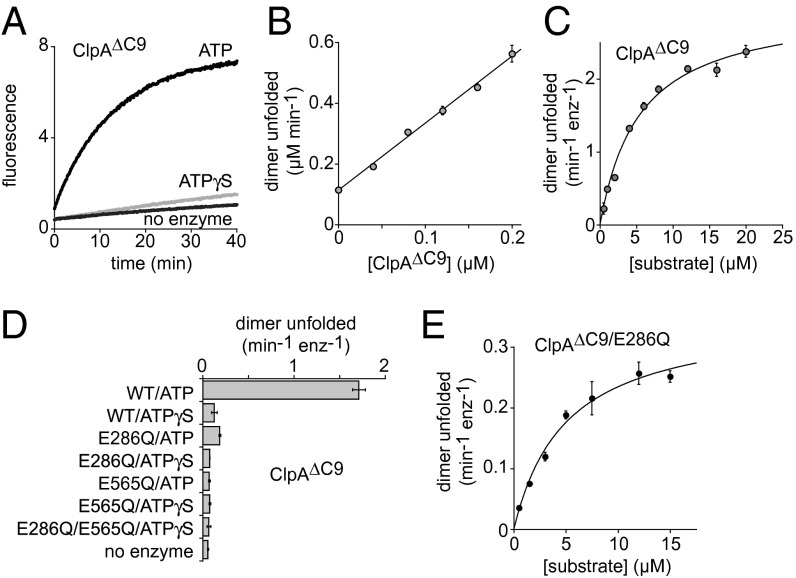Fig. 3.
ClpA catalyzes unfolding of Arc-Gcn4-ssrA with both AAA+ rings playing important roles. (A) Unfolding of Arc-Gcn4-ssrA dimers (2.5 µM donor labeled; 2.5 µM acceptor labeled) alone and catalyzed by ClpA∆C9 (0.2 µM hexamer) in the presence of ATP or ATPγS (5 mM). Curves are averages of two experiments. Fluorescence units are arbitrary. (B) Rates of unfolding of Arc-Gcn4-ssrA dimers (10 µM donor labeled; 10 µM acceptor labeled) varied linearly with ClpA∆C9 concentration in the presence of ATP (5 mM). The line is a linear fit; y = 0.11 + 2.2x (R = 0.997). Values are averages (n ≥ 2) ± SD. (C) Increasing concentrations of equimolar donor- and acceptor-labeled Arc-Gcn4-ssrA were added to ClpA∆C9 (0.08 µM) in the presence of ATP (5 mM) and initial unfolding rates were determined. Fitting to the Michaelis–Menten equation gave a Vmax of 3.0 ± 0.09 dimers unfolded min−1⋅enz−1 and a KM of 5.5 ± 0.45 µM. Values are averages (n = 3) ± SD. (D) Rates of unfolding of Arc-Gcn4-ssrA dimers (2.5 µM donor labeled; 2.5 µM acceptor labeled) by ClpA∆C9 or variants (0.2 µM) in the presence of ATP or ATPγS (5 mM). Values are averages (n = 2) ± SD. (E) Michaelis–Menten analysis of unfolding by ClpA∆C9/E286Q (0.2 µM) and ATP (5 mM) gave a Vmax of 0.35 ± 0.02 dimers unfolded min−1⋅enz−1 and a KM of 4.9 ± 0.65 µM. Values are averages (n = 3) ± SD.

